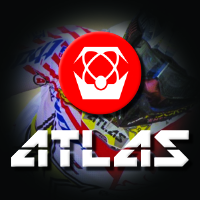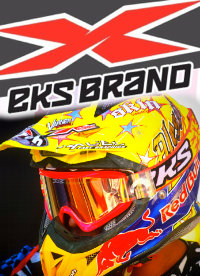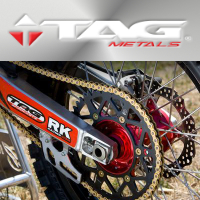Danny Laporte interview
 Tuesday, April 11, 2017 at 4:21PM
Tuesday, April 11, 2017 at 4:21PM Danny Laporte

With a list of victories that place him as one of the greatest American racers of all time, Danny Laporte is very much a rider with a great history in the sport. The 1979 500cc AMA motocross champ, 1992 world 250cc champ, and 1981 MXdN winner, with Team USA, Laporte is a rider who knew how to win in all conditions. He also finished second in the 1992 Dakar rally, when it was really a lot tougher than it now is.
Now working with FMF in America, Danny keeps involved in the sport, continues to ride all over the world, either with friends or in classic events. He is as passionate about the sport now as he ever was, and recently visited the Grand Prix of Mexico, where his fellow countryman, Thomas Covington took victory, riding with an FMF pipe.
We caught up with Danny and asked him about his visit to Mexico, and his thoughts on motocross and supercross tracks.
MXlarge: Danny, first tell me, why did you travel to Mexico for the GP. I am pretty sure you have been a few times or not?
Laporte: Yes, we have been to all three in Mexico. We go riding in Mexico a lot, more the retired type of guys, ex pro guys, or old friends. We like the pace in Mexico, its kick back, and really relaxed. Leon is a really nice region, and a bunch of really nice cities in the area. Obviously, we (FMF) sponsor the GP series, and it’s a great chance to not have to fly all the way to Europe and still get to see a GP. It is very relaxed at these fly-away races. If you go to a race in Europe everyone is there, so it’s hard to talk to people, but in Mexico, they have that big tent that fields the paddock, and it’s really easy to talk to the people we have to deal with. It’s like a big family and people have more time and that is a good reason to go there on the business side of things. We don’t want to get in the way in the big races in Europe.
MXlarge: It can be a tough couple of months for the GP riders with those four fly-away racing starting the series, can’t it?
Laporte: For the guys being on the road that long, with the week break between Argentina and Mexico, it’s a long couple of weeks, flying to Europe and back. Those are long flights from Europe.
MXlarge: You got a bit lucky, having an American win in Mexico, and also an FMF sponsored rider. What is that like for you, being a six time GP winner, an America, and you are watching this young kid, Covington standing on the podium with the American national anthem playing?
Laporte: I mean, it’s great. He won two years ago there, and then comes back and wins it again. For us it’s cool, because we sponsor the team, and it’s really fun. We had to bring some mufflers into Mexico, and getting stuff through the border isn’t always easy. Going through customs with product isn’t easy. It was nice, because we felt like we were part of the deal. Seeing an American win, I enjoy it a lot. I mean the tracks are so diverse in Europe. For Thomas, he didn’t really know the tracks and he is starting to learn them better. The track in Mexico, it might look easy on television, but it’s so hard to ride. You never know what you will get. The dirt in Mexico is like clay and they rip it really a lot, then water it, then the riders practice on it, then when the clay dries, the ruts get really deep and they are like concrete. The ruts are like big waves ready to brake and they go right up to your radiator shrouds, and then you have to jump and land, and try and get into one of these ruts to go through the corner. You can’t make a mistake otherwise you go down. You can see the riders tip toe their way around the track. It’s not forgiving like Argentina where you blow a line and you can still get through the corner, in Mexico you had to really ride like on a rail.
MXLarge: When you used to race, obviously, all the track were natural terrain tracks. I guess America was similar, but did you ever have any tracks like that one in Mexico back when you raced?
Laporte: Funny you should ask that, because we were joking it’s a lot like Saddleback. Its black hard clay, you know in California we had a lot of tracks like that, even Carlsbad. They never ripped Carlsbad, but they ripped Saddleback, and when they did that you had big lumps of clay like a football, you could hardly ride through them in practice. So, Mexico is similar to some tracks in California and Thomas would have been the king of Saddleback. I don’t know where he got those skills from, he came from back east, maybe they have that Georgian clay and its hard pack. A lot of tracks in Europe are like concrete and they hardly touch the tracks. Payerne in Switzerland, they used to have the cows on it, and then open it for the Grand Prix every year, then the cows would be back on it again after the racing ended.
MXlarge: Speaking about that. I have only been here 25 years, but I remember when I first got here, you would go to tracks for a GP and the water damage from winter would still be on the tracks when the riders did the first practice. Long lanes of water damage and the riders would just get on with it. That has changed, now hasn’t it? I am also guessing when you raced in America the tracks were not prepared like they are now. Carlsbad, Saddleback, those tracks were also pretty rough. Now they are really groomed and look very pretty, but are maybe easier to ride?
Laporte: I think the GP tracks have become a little like America tracks, triples, whoop sections, rhythm sections. I like to see a little air, but sometimes it’s over done. The strange side is that supercross are designed to the millimetre, the jumps, the whoops, the step-ups, it’s all done perfectly, built on a computer and all the riders get these track designs and it isn’t spontaneous anymore. Everyone can do the same thing and when you get to a track, they already know what the track will be and what they are going to do. I think it makes racing worse. That is why I love endurecross, because its unpredictable. Everyone is riding the same stuff.
MXlarge: I am not really a fan of supercross, because to me, a non-racer, it all looks the same, every single week. Stadiums look the same. Maybe some tracks like San Diego in 1986. That track was so flat, and the racing was awesome.
Laporte: Absolutely, and what happens when you build a track like what we have now, there is a sweet spot, and if you get out of that, you lose time, so it’s very much following the leader. So how do you get around a guy, that is why we see guys taking guys out in turns. Sometimes it makes the racing worse. They got carried away with the jumps. People want to see a good race and you race on the ground. The way they build these tracks it forces you to follow. That is why I don’t like supercross, because it’s dangerous. I mean putting a 500cc bike in supercross, it’s dangerous.
MXlarge: In supercross, it seems like the riders at times don’t have time to think. I mean I am not a racer and was never a racer, but it seems like that to me as a fan.
Laporte: It’s very hard, and it’s a matter of time that a guy gets hurt like that. Coming down on faces of jumps. I mean outdoors Tomac also got hurt outdoors. The racing isn’t as good as it used to be, because the tracks are now sent to the teams and everyone knows what they get and it seems like the riders and teams are determining how the track will be. I guess it happened back in the day with riders talking to the track builder, and getting a track they wanted. I know through from 1985 until the 90s when they started giving the track designs to everybody.










Reader Comments